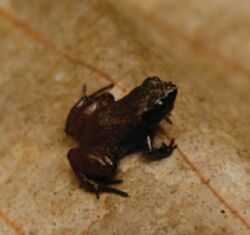Biology:Adelophryne gutturosa
| Adelophryne gutturosa | |
|---|---|

| |
| Scientific classification | |
| Domain: | Eukaryota |
| Kingdom: | Animalia |
| Phylum: | Chordata |
| Class: | Amphibia |
| Order: | Anura |
| Family: | Eleutherodactylidae |
| Genus: | Adelophryne |
| Species: | A. gutturosa
|
| Binomial name | |
| Adelophryne gutturosa | |
Adelophryne gutturosa (common name: Guiana Shield frog) is a species of frogs in the family Eleutherodactylidae.[2] It is found on the Guiana Shield from eastern Venezuela through Guyana[3] to French Guiana and adjacent Brazil (Amapá), possibly extending to Suriname. Its type locality is Mount Roraima.[2][4] Its local Spanish name is ranita guturosa.[1]
Taxonomy
Recent molecular research suggests that A. gutturosa consists of more than one species.[5]
Description
Adult males measure 12.4–14.7 mm (0.49–0.58 in) and females 12.6–16 mm (0.50–0.63 in) in snout–vent length.[6][3][7] The snout is truncate. The head is slightly wider than the body. The tympanum is small but distinct. The canthus rostralis is indistinct. Females have a horizontal supra-tympanic fold. The fingers have asymmetrically pointed tips but no discs, whereas the toe tips have grooved, asymmetrically pointed discs. Skin is smooth.[6] The dorsum is light brown and flanks are black.[7] Males have large subgular vocal sac.[6]
Habitat and conservation
Adelophryne gutturosa occurs in the leaf-litter on the forest floor of rainforests near streams at elevations of 40–2,200 m (130–7,220 ft) above sea level. Males call from the base of plants (often formations of Monotagma spicatum), hidden among rootlets and dead leaves.[1]
This species is not common, although its secretive habits also make it difficult to find. No significant threats to it have been identified, and its range includes several national parks.[1]
References
- ↑ 1.0 1.1 1.2 1.3 Reynolds, R.; Rodrigues, M.T.; Mijares, A.; MacCulloch, R. (2004). "Adelophryne gutturosa". IUCN Red List of Threatened Species 2004: e.T56301A136553526. doi:10.2305/IUCN.UK.2004.RLTS.T56301A11452512.en. https://www.iucnredlist.org/species/56301/136553526. Retrieved 27 November 2023.{{cite iucn}}: error: |doi= / |page= mismatch (help)
- ↑ 2.0 2.1 Frost, Darrel R. (2017). "Adelophryne gutturosa Hoogmoed and Lescure, 1984". Amphibian Species of the World: an Online Reference. Version 6.0. American Museum of Natural History. http://research.amnh.org/vz/herpetology/amphibia/Amphibia/Anura/Brachycephaloidea/Eleutherodactylidae/Phyzelaphryninae/Adelophryne/Adelophryne-gutturosa. Retrieved 9 June 2017.
- ↑ 3.0 3.1 MacCulloch, R.D.; A. Lathrop; P.J.R. Kok; L.R. Minter; S.Z. Khan; C.L. Barrio-Amorós (2008). "A new species of Adelophryne (Anura: Eleutherodactylidae) from Guyana, with additional data on Adelophryne gutturosa". Zootaxa 1884: 36–50. doi:10.11646/zootaxa.1884.1.2.
- ↑ MacCulloch, R.D.; A. Lathrop; R.P. Reynolds; J.C. Señaris; G.R. Schneider (2008). "Herpetofauna of Mount Roraima, Guiana shield region, northeastern South America". Herpetological Review 38: 24–30.
- ↑ Fouquet, A.; D. Loebmann; S. Castroviejo-Fisher; J.M. Padial; V.G.D. Orrico; M.L. Lyra; I.J. Roberto; P.J.R. Kok et al. (2012). "From Amazonia to the Atlantic forest: Molecular phylogeny of Phyzelaphryninae frogs reveals unexpected diversity and a striking biogeographic pattern emphasizing conservation challenges". Molecular Phylogenetics and Evolution 65 (2): 547–561. doi:10.1016/j.ympev.2012.07.012. PMID 22842094.
- ↑ 6.0 6.1 6.2 Hoogmoed, M.S.; Lescure, J. (1984). "A new genus and two new species of minute leptodactylid frogs from northern South America, with comments upon Phyzelaphryne (Amphibia: Anura: Leptodactylidae)". Zoologische Mededelingen 58 (6): 85–115. http://repository.naturalis.nl/record/319080.
- ↑ 7.0 7.1 Hoogmoed, M.S.; Borges, D.M.; Cascon, P. (1994). "Three new species of the genus Adelophryne (Amphibia: Anura: Leptodactylidae) from northeastern Brazil, with remarks on the other species of the genus". Zoologische Mededelingen 68 (24): 271–300. http://repository.naturalis.nl/record/319391.
Wikidata ☰ Q2246670 entry
 |


